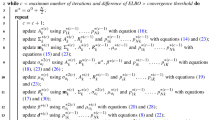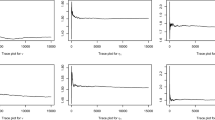Abstract
This paper presents a Bayesian approach for fitting the standard power-law rating curve model to a set of stage-discharge measurements. Methods for eliciting both regional and at-site prior information, and issues concerning the determination of prior forms, are discussed. An efficient MCMC algorithm for the specific problem is derived. The appropriateness of the proposed method is demonstrated by applying the model to both simulated and real-life data. However, some problems came to light in the applications, and these are discussed.




Similar content being viewed by others
References
Ackers P, White WR, Perkins JA, Harrison AJM (1978) Weirs and flumes for flow measurement. Wiley, UK
Árnason S (2005) Estimating nonlinear hydrological rating curves and discharge using the Bayesian approach. Masters Degree, Faculty of Engineering, University of Iceland
Balendra T, Shah DA, Tey KL, Kong SK (2002) Evaluation of flow characteristics in the NUS-HDB Wind Tunnel. J Wind Eng Indus Aerodyn 90:675–688
Barnes HH (1967) Roughness characteristics of natural channels. U.S. Geological Survey water-supply paper 1849, U.S. Government Printing Office, Washington
Chow VT (1958) Open channel hydraulics. McGraw-Hill, New York
Clarke RT (1999) Uncertainty in the estimation of mean annual flood due to rating curve indefinition. J Hydrol 222:185–190
Denison DGT, Holmes CC, Mallick BK, Smith AFM (2002) Bayesian methods for nonlinear classification and regression. Wiley, UK
Dury GH (1961) Bankfull discharge: an example of its statistical relationships. IASH Bull 6:48–55
Fenton JD (2001) Rating curves: part 2, representation and approximation. Proc Conf Hydraul Civ Eng, Hobart:28–30 November, Inst Eng, Australia
Gelman A, Carlin JB, Stern HS, Rubin DB (2004), Bayesian data analysis, 2nd edn. Shapman & Hall/CRC, Boca Raton
Greenwood MC, Humphrey NF (2002) Glaciated valley profiles: an application of nonlinear regression. In: Proceedings of Symposia on Interfaces, Canada
Griffiths GA (1980) Hydraulic geometry relationships of some New Zealand gravel-bed streams. J Hydrol (NZ) 19:106–118
Herschy RW (1978) Accuracy. In: Herschy RW (ed) Hydrometry: principles and practices, 1st edn. Wiley, UK
Herschy RW (1995) Streamflow measurement, 2nd edn. E & FN Spon, London
ISO 1100/2 (1998) Stage-discharge relation. Geneva
Lambie JC (1978) Measurement of flow-velocity-area methods. In: Herschy RW (ed) Hydrometry: principles and practices, 1st edn. Wiley, UK
Leopold LB, Maddock T (1953) The hydraulic geometry of stream channels and some physiographic implications. US Geol Surv Water Supply Pap :252
Mohamoud YM, Paramar RS (2006) Estimating streamflow and associated hydraulic geometry, the mid-Atlantic region. J Am Water Resour As (JAWRA) 42:755–768
Mosley MP, McKerchar AI (1993) Streamflow. In: Maidment DR (ed) Handbook of hydrology. McGraw-Hill, New York
Moyeed RA, Clarke RT (2005) The use of Bayesian methods for fitting rating curves, with case studies. Adv Water Res 28(8):807–818
Osterkamp WR, Hedman ER (1977) Variation of width and discharge for natural high-gradient stream channels. Wat Res 13:256–258
Park CC (1976) The relationship between slope and stream channel form in the river dart, Devon. J Hydrol 29:139–147
Park CC (1977) World-wide variations in hydraulic geometry exponents of stream channels: an analysis and some observations. J Hydrol 33:133–146
Petersen-Øverleir A (2004) Accounting for heteroscedasticity in rating curve estimates. J Hydrol 293:173–181
Petersen-Øverleir A (2005) A hydraulics perspective on the power-law rating curve. NVE report 05-05, Norwegian Water Resources and Energy Directorate, 28 pp
Petersen-Øverleir A (2006) Modelling stage-discharge relationships affected by hysteresis using the Jones formula and nonlinear regression. Hydrol Sci 51:365–388
Petersen-Øverleir A, Reitan T (2005) Objective segmentation in compound rating curves. J Hydrol 311:188–201
Rantz SE and others (1982) Measurement and computation of streamflow, Vol. 2. Computation of Discharge. U.S. Geological Survey Water-Supply Paper 2175, U.S. Geological Survey, Reston, Virginia, US
Reitan T, Petersen-Øverleir A (2006), Existence of the frequentistic regression estimate of a power-law with a location parameter, with applications for making discharge rating curves. Stoc Env Res Risk Asses 20:6:445–453
Stephan U, Gutknecht D (2002) Hydraulic resistance of submerged flexible vegetation. J Hydrol 269:27–43
Venetis C (1970) A note on the estimation of the parameters in logarithmic stage-discharge relationships with estimation of their error. Bull Int Assoc Sci Hydrol 15:105–111
Whitfield PH, Hendrata M (2006) Assessing detectability of change in low flows in future climates from stage-discharge measurements. Can Wat Res J 31:1–12
Acknowledgments
The authors would like to thank Geir Storvik for his help in making an efficient MCMC algorithm. Our thanks to Nils Lid Hjort for addressing the question of the properness of the posterior for flat h 0 prior and the problem of robustness. Bent Natvig is thanked for a series of detailed comments on two drafts of the paper. Adrian Read should be thanked for reading and correcting the manuscript.
Author information
Authors and Affiliations
Corresponding author
Appendix: Case study data and code
Appendix: Case study data and code
The stage-discharge measurement data used in the case studies as well as the code used in this paper can be accessed at http://www.folk.uio.no/trondr/hydrasub/ratingcurve.html.
1.1 Finiteness of the expected discharge for the semi-conjugate prior
In order to calculate the posterior expectation of the discharge, Q, given h 0, one needs to integrate the product of π(a, b), π(σ2), f(D|a, b, h 0, σ2) and Q(h, a, b, h 0) over the parameters a, b and σ2. Only π(σ2) and f(D|a, b, h 0, σ2) contains σ2. The integral
is obtained by identifying the integral as the normalization of an inverse-gamma distribution, see also Eq. 9.
Defining the prediction design vector x 0(h) = (1 log(h − h 0))t, an upper limit for the expected discharge can be found:
This is a two-dimensional quadratic term integral, which has a finite value since the quadratic term in the exponent is negative. Thus given h 0, the expected discharge is finite.
Rights and permissions
About this article
Cite this article
Reitan, T., Petersen-Øverleir, A. Bayesian power-law regression with a location parameter, with applications for construction of discharge rating curves. Stoch Environ Res Risk Assess 22, 351–365 (2008). https://doi.org/10.1007/s00477-007-0119-0
Published:
Issue Date:
DOI: https://doi.org/10.1007/s00477-007-0119-0




